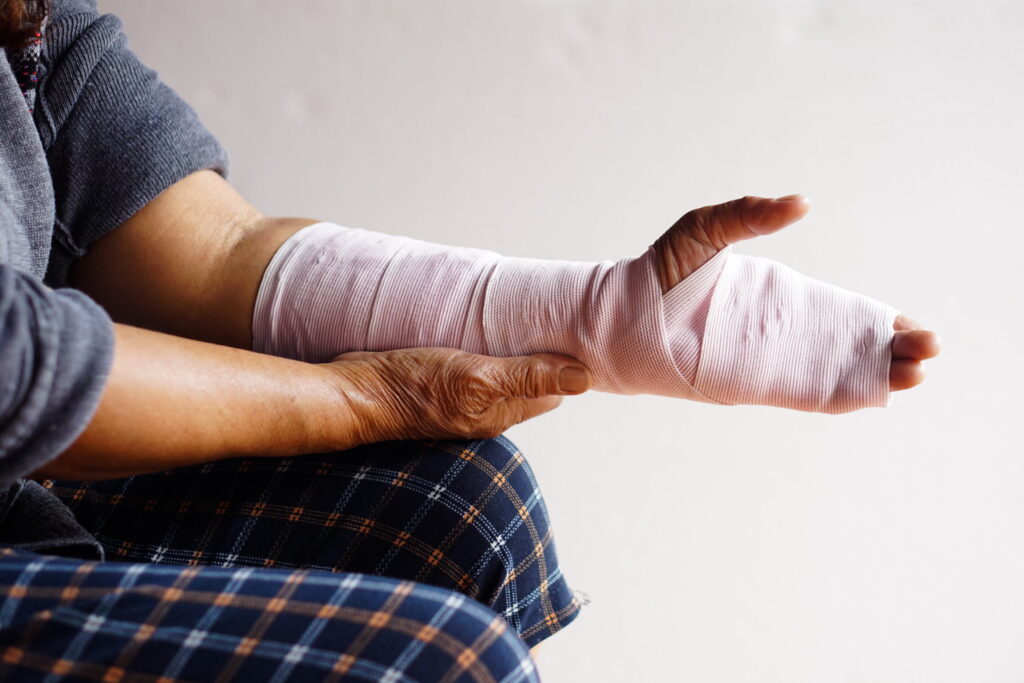When the body experiences a sudden fracture, many of its essential motor activities cease, negatively impacting daily life.
In fact, bone fractures are common injuries that anyone at any age can suffer, whether due to a sudden accident, a simple fall, or even repetitive stress.
Although bones have an amazing ability to heal themselves, understanding the different types of fractures, their severity, and available treatment options is crucial to ensure proper recovery and avoid complications.
Dealing with fractures requires high precision and skill; it’s not just about realigning the bone, but about restoring the full function of the injured limb.
Here, it’s important to mention the global expertise and quality of care at Liva Hospital in Turkey, which adopts modern, evidence-based protocols to address these fractures.

Bone Fractures: Types, Causes, and Symptoms
Let’s first explain what bone fractures are. A fracture is a break in the continuity of a bone, ranging from a tiny, barely visible crack to a complete shattering of the bone.
Fracture types vary significantly based on the shape of the break, its location, and the extent of damage, which directly influences the treatment plan.
Common Fracture Types
- Closed Fracture (Simple Fracture): This is a fracture that does not break the skin, with the broken bone remaining inside the body. Despite being closed, it can be severe and require surgical intervention.
- Open Fracture (Compound Fracture): In this type, the broken bone pierces the skin, exposing it to external factors and significantly increasing the risk of infection. This type of fracture is an emergency requiring immediate treatment.
- Transverse Fracture: Occurs when the fracture line is straight across the bone, perpendicular to the long axis of the bone.
- Oblique Fracture: The fracture line is at an angle across the bone.
- Spiral Fracture: Results from a strong twisting force, with the fracture line appearing as a spiral around the bone. Often associated with sports injuries or accidents involving limb torsion.
- Comminuted Fracture: In this type, the bone breaks into three or more pieces, often resulting from a strong and violent impact.
- Greenstick Fracture: Common in children, where the bone bends and breaks only partially on one side, like breaking a green twig.
- Avulsion Fracture: Occurs when a small piece of bone separates from the main bone due to a strong pulling force from a tendon or ligament.
- Stress Fracture: Caused by repetitive stress and small forces on the bone over time, rather than a single traumatic event. Common in athletes.
- Pathologic Fracture: Occurs in an already weakened bone due to an underlying disease such as osteoporosis, tumors, or infection, even with minor injury or none at all.
Causes of Fractures
The causes of fractures are numerous, but generally center around:
- Direct Trauma: Such as falls, car accidents, or sports injuries.
- Repetitive Stress: Especially in cases of stress fractures in athletes.
- Diseases that Weaken Bones: Such as osteoporosis, or certain types of cancer that spread to the bones.
Common Symptoms of a Fracture
- Severe and sudden pain that worsens with movement.
- Swelling and bruising around the injured area.
- Visible deformity in the injured limb (e.g., an abnormal angle).
- Inability to move the injured part or bear weight on it.
- In open fractures, there may be bleeding and exposed bone.
Accurate Diagnosis Precedes Fracture Treatment
No fracture treatment plan can begin without an accurate diagnosis that identifies the type of fracture, its location, the extent of damage, and any potential complications.
The diagnostic process usually begins with a comprehensive clinical evaluation by a doctor.
Clinical Evaluation
- Medical History: The doctor asks about how the injury occurred, symptoms, and the patient’s medical history (chronic diseases, medications, allergies).
- Physical Examination: The doctor examines the injured area for swelling, bruising, deformity, pain on touch, and assesses the range of motion (if possible) and the neurovascular status of the limb (checking pulse and sensation) to ensure no nerve or blood vessel damage.
Imaging Tests
- X-rays: These are the primary and most common tests for diagnosing fractures.
They can clearly show the fracture’s location, type, and degree of bone displacement. Images are taken from multiple angles to get a comprehensive view. - CT Scan (Computed Tomography): Used when X-rays are insufficient, especially for complex fractures, joint fractures, or spinal and pelvic fractures.
It provides three-dimensional images of the bones, helping the surgeon understand the fracture details and plan surgery precisely. - MRI (Magnetic Resonance Imaging): Useful for evaluating soft tissues surrounding the broken bone, such as ligaments, tendons, muscles, blood vessels, and nerves, as well as for diagnosing stress fractures that may not appear on initial X-rays, or for detecting avascular necrosis.
- Bone Scan: Sometimes used to detect stress fractures or occult fractures that do not show up in other tests, or to evaluate the presence of other bone diseases.
Fracture Treatment: Reduction, Immobilization, and Rehabilitation
The principles of fracture treatment are based on two main goals: realigning the bone to its correct anatomical position (reduction) and immobilizing it in that position until it heals (fixation), then restoring the function of the injured part (rehabilitation).
The method of achieving these principles varies based on the fracture type, location, patient’s age, and general health condition.
First: Reduction
Reduction means realigning the broken bone fragments to their natural position. This reduction can be:
- Closed Reduction: The bone is manually realigned from the outside, without the need for surgical incision. This is usually done under local or general anesthesia to minimize pain.
- Open Reduction: This type requires a surgical procedure to open the skin and access the broken bone to realign its fragments. It is often done for complex or open fractures.
Second: Immobilization/Fixation
After reduction, the bone must be immobilized to ensure proper healing. Immobilization can be external or internal:
External Fixation
- Cast: This is the most common method for immobilizing closed and simple fractures. It is made of plaster or fiberglass and completely immobilizes the injured part.
- Braces/Splints: Provide less support than a full cast and may allow some movement. They are used for specific fractures or as support after cast removal.
- External Fixator: Consists of pins or screws inserted into the bone through the skin and connected to an external metal frame.
This type is used for severe open fractures, comminuted fractures, or when internal fixation is not immediately possible due to severe swelling or infection.
Internal Fixation (ORIF – Open Reduction and Internal Fixation)
This type is used for fractures that cannot be effectively reduced and immobilized by external methods, or for fractures that require absolute stability.
Reduction is performed first (often surgically), then metal implants are used to fix the bone:
- Pins and Wires: Used to fix small bone fragments or for specific fractures.
- Plates and Screws: One of the most common methods, where a metal plate is secured to the surface of the broken bone with screws to provide strong stability.
- Intramedullary Nails: These long nails are inserted into the central cavity of the bone (marrow) to stabilize it from within. Commonly used for long bone fractures such as the femur or tibia.
Third: Rehabilitation
After fracture healing and initial immobilization, the rehabilitation phase begins, which is essential for regaining full function and strength. It includes:
- Physical Therapy: Aims to restore range of motion, strengthen surrounding muscles, and improve coordination and balance.
- Occupational Therapy: Helps patients regain the ability to perform daily living activities.

Conservative Treatment Options for Fractures
Conservative (non-surgical) treatment is the first choice for many fractures, especially those that are stable, not significantly displaced, or occur in children.
This approach relies on the principles of closed reduction and external immobilization, aiming to allow the bone to heal naturally without the need for surgical intervention.
- Casts: The cast is the primary tool in conservative treatment. After the doctor manually reduces the fracture and realigns the bone, the cast is applied. Casts are usually made of plaster or fiberglass.
The cast provides complete immobilization of the broken bone and prevents its movement, allowing bone cells to grow and repair the fracture.
The cast is regularly checked to ensure it is not pressing on nerves or blood vessels.
The duration of cast wear varies depending on the type and location of the fracture and the patient’s age, but it is typically between 4 to 12 weeks. - Splints/Braces: These devices are used to provide less support than a full cast.
Splints are usually used in the initial phase after injury to allow swelling to subside, or in cases that do not require full immobilization.
Braces are typically made of rigid, lightweight materials and are used for specific fractures that allow some limited movement, or as support after a full cast is removed during the rehabilitation phase.
For example, special braces may be used for stable spinal fractures or ankle fractures. - Rest and Activity Restriction: In some cases of stress fractures or hairline fractures, conservative treatment may be as simple as rest and avoiding the activity that caused the fracture.
The patient is instructed to reduce weight-bearing on the injured part to allow the bone to heal naturally. Crutches or a walker may be required to reduce weight on the injured lower limb. - Pain Management: Pain management is an essential part of conservative treatment. Pain relievers are prescribed as needed, and ice may be recommended to reduce swelling and pain, and to elevate the injured limb.
Conservative treatment is an effective and safe option for many fractures, but it must be performed under strict medical supervision to ensure proper fracture healing.
Surgical Intervention for Fracture Treatment
When conservative treatment is insufficient or inappropriate, surgical intervention becomes a necessity to ensure proper fracture healing and optimal function restoration.
Surgery is resorted to in specific cases that require stronger fixation or precise realignment of the bone.
- Open Reduction and Internal Fixation (ORIF): As mentioned previously, the skin is opened to access the fracture, then the bone is realigned and fixed using plates and screws, intramedullary nails, or wires.
- External Fixation: Used in complex or open cases, where pins or screws are inserted into the bone and connected to an external frame. The frame can be adjusted over time to fine-tune bone alignment.
- Arthroplasty/Partial or Total Joint Replacement: In some severe fractures that completely destroy the joint surface (especially in the hip or shoulder), joint replacement may be the best option to restore function and relieve pain.
Specialized centers like Liva Hospital in Turkey offer the latest technologies in this field, ensuring the best outcomes for patients who require this type of intervention.
Conclusion
Bone fractures are a health challenge that requires deep understanding and precision in diagnosis and treatment.
From simple fractures requiring casts to complex fractures necessitating intricate surgical interventions, the primary goal remains the same: restoring bone integrity and the function of the injured limb.
Advancements in diagnostic techniques, materials used in surgical fixation, and rehabilitation programs have revolutionized fracture treatment, providing better outcomes for patients.
The role of the integrated medical team, from the specialized orthopedic surgeon to physical and occupational therapists to nurses, is invaluable.
Advanced healthcare facilities, such as Liva Hospital in Turkey, provide an exemplary model for delivering the latest treatments and comprehensive care for fracture patients.
Frequently Asked Questions
How long does it take for a fracture to heal?
The healing time for a fracture varies significantly depending on the type of fracture, its location, the patient’s age, and overall health.
Should I take calcium or vitamin D supplements to help with fracture healing?
If your diet is deficient in calcium or vitamin D, your doctor may recommend supplements. These nutrients are essential for overall bone health and play a role in the healing process, but they are not a substitute for prescribed medical treatment.
Will I need surgery to remove plates and screws after the fracture heals?
It depends on several factors, including the location of the metal, whether it causes any discomfort or pain, and the patient’s age. In some cases, removal is not necessary, while in others, a simple procedure may be performed.
When can I return to sports after a fracture?
This should be done gradually and under the supervision of a doctor or physical therapist. The duration varies depending on the type and severity of the fracture, but it usually requires several months of intensive rehabilitation before returning to full sports activities.
What if the fracture does not heal properly?
If the fracture does not heal (non-union) or heals incorrectly (malunion), additional medical intervention may be needed. This may include surgery for re-fixation, bone grafting, or other procedures to stimulate healing.
Can I drive a car with a cast?
It is not advisable to drive a car with a cast on a limb, especially if it affects your ability to safely control the vehicle. This may even be illegal in some places and increases the risk of accidents. Always consult your doctor about when you can safely return to driving.



